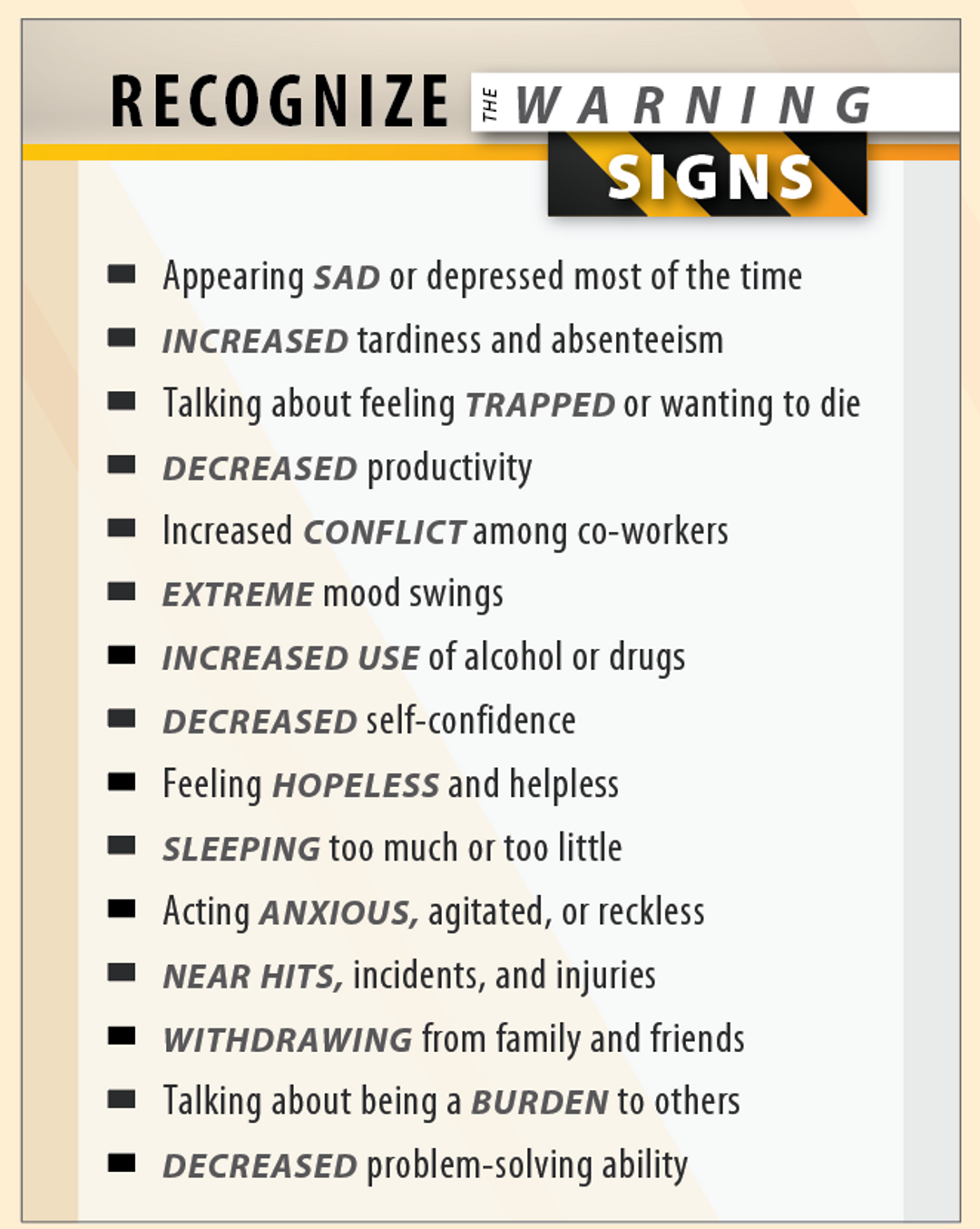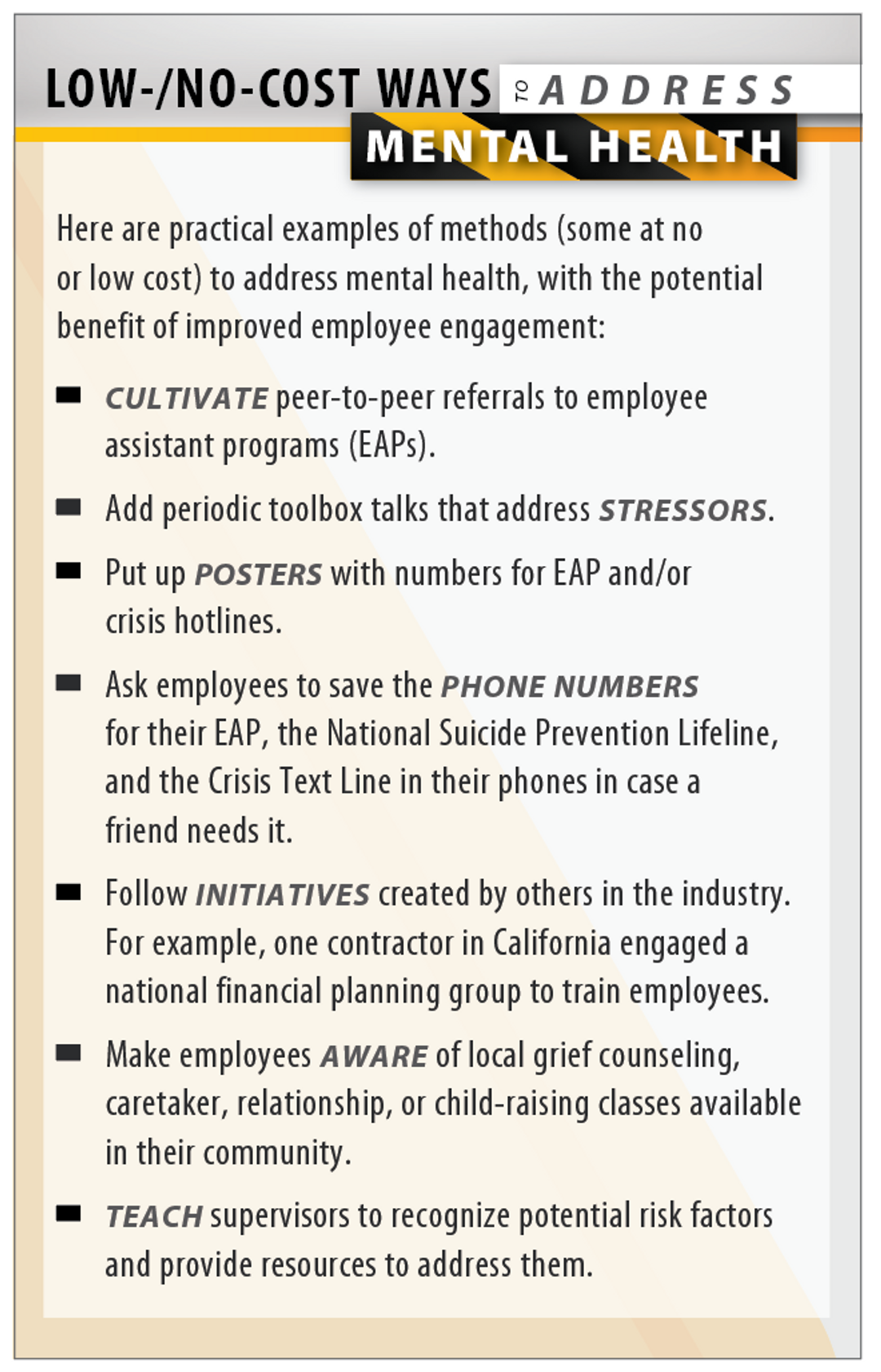A trucker drives off the berm of the road, rolling his vehicle; while he was not injured, an analysis reveals no known reason for the accident. An experienced mechanic “forgets” to tighten a bolt while making a repair.
A group of heavy equipment operators are told to keep their eyes on a fellow operator who recently separated from his wife.
Unfortunately, these and other similar scenarios are very real indicators of mental health issues or suicide risk factors. In fact, the Centers for Disease Control (CDC) recently issued an updated report1 ranking construction as the occupational group with the highest suicide rate in 2012 and 2015 among males (43.6 and 53.2 per 100,000 working persons in all occupational groups, respectively).2
As such, it is an industry imperative to address mental health as a safety mandate. Contractors must seek to adjust their sound risk management programs to address mental health and involve their frontline safety professionals or supervisors to help mitigate losses associated with mental health.
Time and again, the construction industry has shown to be a leader in accident prevention, consistently integrating innovative safety measures into high-pressure, deadline-driven environments.
For example, as a young safety professional, I was responsible for introducing the new fall protection requirements of the Occupational Safety and Health Administration (OSHA) to a group of experienced ironworkers. Their vocal objections to the requirements were intimidating, and many resolved in frustration that they would “never get any work done” if they had to tie off wearing a heavy tool belt. However, those same ironworkers ultimately responded by inventing tools like the beamer, which allows them to walk along the beam while remaining safely tied off. And they are performing more work on the ground to reduce the exposure to working at heights.
Construction must continue to make progress in safety to now include mental health and suicide prevention.
Construction Safety: Connecting Mental Health
& Workplace Injuries
The connection between employee mental health and overall workplace safety must no longer be ignored. Adding logical risk control methods related to mental health will result in a safer, more productive workplace. Given the significant pressure to avoid safety-related costs, construction employees are often involved in daily, weekly, and sometimes full-day training sessions to fulfill OSHA and customer safety standards and requirements. Fortunately, training remains worthwhile, as employees are more knowledgeable about safety requirements than ever.
Whether it is human error or a lack of skill, knowledge, or experience, it is well established that unsafe behavior is a leading immediate cause of accidents. Through the investigation process, if it is determined that a site norm or any other visual factor was not the cause of an injury, then a mental distraction could have contributed.
The impact of mental health on workplace incidents becomes even more compelling when recent research is considered:
- Construction has the highest male suicide rate across all industries.3
- A 2016 report cited intentional injuries by people (including violence and suicide) across all industries were the second-highest for all on-the-job fatalities.4
- A 2016 study by the Colorado School of Public Health reviewed 17,000 workers’ comp claims and found that 60% of women and 33% of men reported a behavioral health condition before the incident.5
- A 2016 survey by the University of Pittsburgh indicated that financial stress inflated the number of accidents for a large trucking company by eight per year.6
Therefore, it is responsible to associate mental health with suicide or errors leading to incidents, quality, or production deficiencies.
Industry professionals are increasingly recognizing that mental health must be addressed by employers. When I recently asked a 20-year safety professional what role he thinks mental health plays in construction safety, he said, “If you would have asked me 10 years ago, I would have laughed and not taken the question seriously. Today, I believe it’s extremely relevant.”
Challenges of Addressing Mental Health
in the Workplace
A recent survey by the National Safety Council’s Safety+Health magazine indicated that 49% of safety professionals agree that mental health should be addressed at the safety professional level.7 However, addressing mental health issues that can lead to violent acts and injuries is often more difficult than addressing “standard” safety issues.
When I spoke with those ironworkers nearly 20 years ago about wearing fall protection, my inarguable response to push back was “it’s the law.” After all, instructing employers and/or employees to change work practices in accordance with legal or customer requirements is ultimately understood. However, it can be more difficult to establish standards related to more complex issues such as mental health, which tends to be viewed as a societal issue rather than an employer issue. But when society fails, the employer is left with the risk.
Mental health stressors – particularly for construction workers – have become more glaring over the years.

Common Construction Risk Factors
There are many risk factors for workplace suicide and mental health-associated injury unique to construction workers. One of the most prevalent is the “tough guy” culture, cultivated by a longstanding environment of peer and leadership expectations.
This tough guy culture, coupled with the stigma associated with mental health, makes the conversation challenging.
Issues such as travel, separation from family, and seasonal employment are also inherent to construction work and challenging to address.
I recently spoke with a well-traveled construction leader about mental stressors and their impact on employees. He stated that “relationship issues are significant stressors for construction workers, especially when travel is involved – combining family separation and the availability of alternative, unhealthy connections through social media.” Construction workers justify the separation as a tradeoff for adequately providing for their families.
An additional challenge with addressing relationship issues is that many men may view such discussions as intrusive. Men generally find it difficult to express emotions and tend to shut down. Psychology Today describes it this way: “their masculine identity conflicts with many emotions they feel and what they feel they are ‘allowed’ to express (i.e., they will be shamed and will feel as if they are ‘not real men’ if they express feelings of vulnerability, dependency needs, weakness, etc.).”8
Financial stressors can weigh heavily on anyone’s mind. For construction workers, the challenge is recurring, as workers can experience stressors of seasonal work. There is a tendency to financially overcommit or spend more money when they are working and not prepare for the downturn or layoff. Since construction has its busy and slow times, the opportunity to overcommit is greater.
Prioritize Mental Health in the Construction Workplace
The opportunity exists to make mental health a risk management priority.
Start the Conversation
One way to overcome the stigma is to just start talking about it. Many people who have life experiences with mental health issues and/or suicide understand that the stigma is minor compared with the consequences of not discussing it. (In fact, my own mother’s death bed regret was not reaching out to a disturbed construction worker before he killed two of our neighbors and seriously injured my father in front of our house, before taking his own life.) The stigma can be overcome.
I was not aware of the network of industry professionals addressing this issue until I reached out to longtime CFMA member and catalyst for suicide prevention in construction, Cal Beyer, who referred me to CFMA and the resources available through the Construction Industry Alliance for Suicide Prevention at www.preventconstructionsuicide.com. As Cal has stated, suicide prevention is “the next frontier in construction safety.”
Our conversation led me to introduce the issue and offer solutions to a small group of construction safety professionals. During a meeting with these colleagues, I cautiously began a discussion on suicide prevention. To my surprise, attendees shared multiple stories about employees who have died by suicide.
One risk manager of a large GC in Pittsburgh discussed suicide prevention with his workforce that same evening. “The topic was accepted with open arms and led to a more than an hour-long discussion. Every employee had some sort of connection to suicide. This is powerful stuff, and these guys showed their emotional side,” he said. He later indicated that the topic created more engagement with his people than any other standard safety topic ever discussed.
Improved employee engagement is a powerful and positive unintended consequence of breaking the stigma and bringing mental health into the risk management conversation. Another consequence occurs in the worker’s home. Many people can relate to family members experiencing mental health issues. Simple tools provided by an employer can give employees the opportunity to share knowledge with family members. Engagement occurs when an employer is helping families.

Include Mental Health in Company Safety Culture
A company can elevate its safety culture by embedding mental health into its overall strategy. Developing a safety culture begins with understanding the ethical, legal, and financial impacts of accidents. The strategies of setting expectations, recognizing symptoms, education, regular communication, and accountability that are used to maintain a safety culture should also include mental health issues.
Effective communication involves weekly, if not daily, job hazard analyses and safety conversations. Traditionally, mental health issues have been relegated to wellness, union, or a human resource issue. While there is no doubt that their involvement is essential, the responsibility needs to expand to the supervisor or safety professional – not at the cost of extra time, but by exchanging a few traditional safety topics with mental health-related topics.
Example of Raising Awareness
OSHA has a strategy to mitigate fatalities through its Focus Four campaign. Focus Four encourages companies to focus on the four leading causes of fatalities: Falls, Electrocution, Struck-By, and Caught-Between incidents. EPIC Insurance and several industry peers are working to raise awareness and provide tools in a risk management strategy that we call Focus Fourward. Focus Fourward encourages organizations to focus on people though safety, wellness, and mental health.
In the current environment where suicide rates are rising and employees are difficult to find and retain, the construction industry must focus beyond just employee safety. By integrating mental health, wellness, and safety into a culture with a foundation of putting people first, companies can improve recruitment, retention, and engagement. The goal is a productive workforce with less interruption.
Cultivating a holistic approach to accident and suicide prevention involves adding a mental health component to the risk management mix, as well as increased training and awareness on EAP resources, addictions, financial responsibility, relationship issues, depression, and anxiety solutions.
Construction Must Continue to Lead
When it comes to accident prevention, the construction industry has been a leader in innovation. It’s time to take the next step by addressing and supporting employee mental health as a safety imperative to prevent suicide and injuries throughout the construction industry.
Endnotes
- www.cdc.gov/media/releases/2018/p1115-Suicide-american-workers.html?utm_campaign=SUICIDE%20PREVENTION.
- www.cdc.gov/mmwr/volumes/67/wr/mm6745a1.htm?s_cid=mm6745a1_e.
- www.cdc.gov/mmwr/volumes/67/wr/mm6745a1.htm?s_cid=mm6745a1_e.
- www.bls.gov/opub/ted/2016/workplace-violence-in-education-training-and-library-occupations.htm.
- www.ucdenver.edu/academics/colleges/PublicHealth/About/news/Pages/Newsroom.aspx?&newsid=1070.
- www.researchgate.net/publication/320616355_The_Price_of_Financial_Precarity_Organizational_Costs_of_Employees’_Financial_Concerns.
- www.safetyandhealthmagazine.com/articles/17489-its-not-an-easy-conversation-mental-health-in-the-workplace.
- www.psychologytoday.com/us/blog/theory-knowledge/201411/why-is-it-so-hard-some-men-share-their-feelings.
Copyright © 2019 by the Construction Financial Management Association (CFMA). All rights reserved. This article first appeared in January/February 2019 CFMA Building Profits magazine.